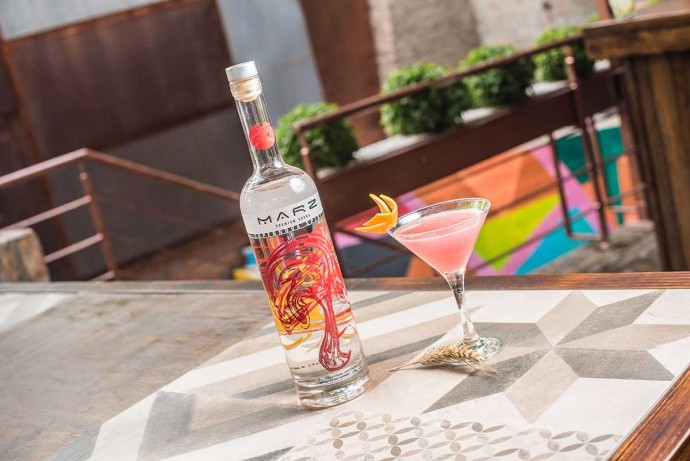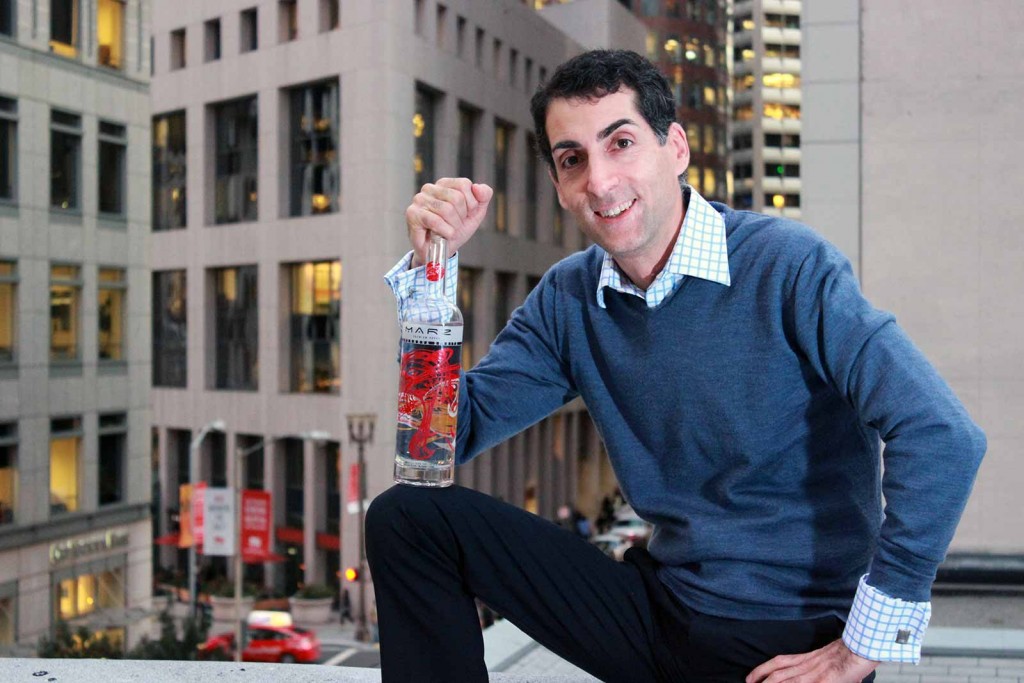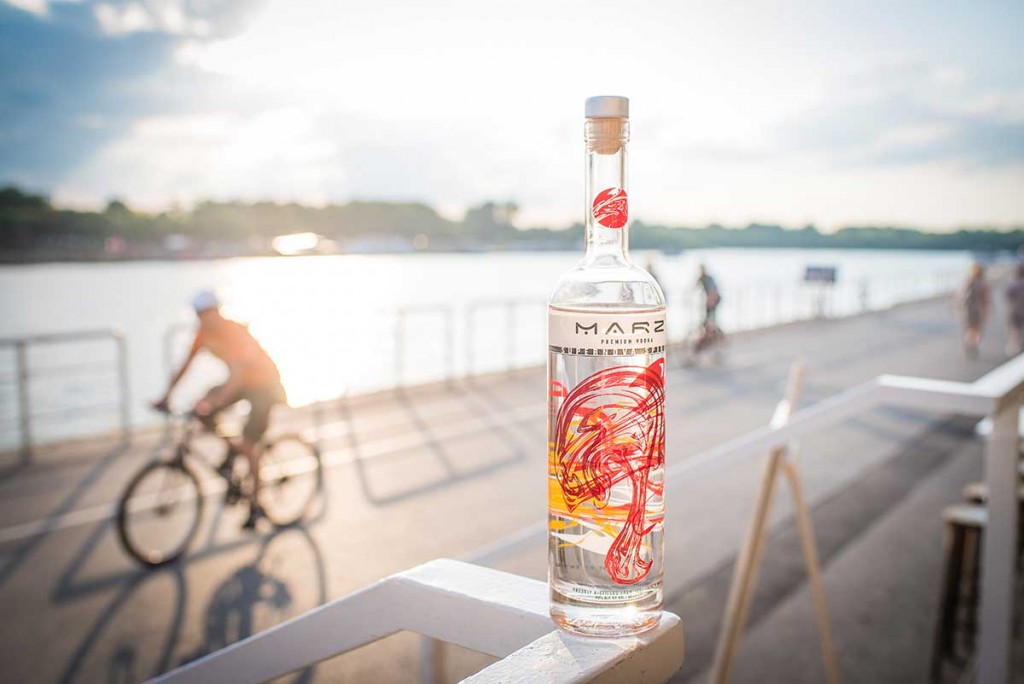California-based Supernova Spirits have always done things a little differently from their competition. Unlike most craft brands, they didn’t start with the help of a master distiller to make their product—instead, they had to lay the groundwork for a sustainable business from scratch before they ever got to taste the first sip of their vodka.
Their story reads more like that of a tech startup, with a scrappy, international team coming together around little more than an idea. But despite getting the ball rolling just over two and a half years ago, and their first bottles entering the market in early 2015, Supernova’s flagship Marz Vodka has exceeded even their wildest expectations.
The Idea
Supernova Spirits was born out of a fairly simple conversation. During a visit to his home in southeast India, an associate of eventual co-founder and COO Ward Karson was introduced to a spirits producer who was looking to import his products to the United States.
“We were talking about this opportunity to import spirits to the US, and it got us thinking about premium spirits as a space we could get into,” Ward told us recently. “Gradually, the conversation shifted from, ‘how do we help this guy import his stuff over here,’ to, ‘hey, maybe we could do this ourselves and send it over there!’ So we talked about what made sense from a business perspective, and since we all love to drink it didn’t take much convincing after that.”
This international focus has been key to Supernova’s mission from the start. Ward and his business partners hail from all over the globe, and their goal is to build a brand that’s as recognizable in Asia and Europe as it is here at home. That said, they know that starting locally is essential to both their business and ensuring that they have a quality product.
“We initially thought about sourcing our spirits from outside the country, but when you go to a liquor store and you look at the various imported products, you realize that they have to deal with import tariffs, customs, and all these fees and documentation, yet they still have to compete for that shelf space with domestic products,” Ward said.
“So if someone’s selling Hangar 1 for $40 a bottle, and someone’s importing a competing vodka like Grey Goose, we look at them and see that the Grey Goose guy has to pay all the extra taxes and shipping and insurance and deal with the time it takes to get here. So we figured, why don’t we just avoid that and make it here locally?”
Crafting a Vodka
Having never made a spirit themselves, the Supernova team’s first challenge was figuring out what they actually wanted to produce. When asked why they eventually decided on a premium vodka, Ward’s answer was twofold.
“The short answer is that it makes up about 26% of the domestic US spirits market, so there’s lots of room for new products to compete. Secondly, though, once you distill a vodka it’s ready to go—there’s no aging involved. We could’ve decided to make a 12-year-old whiskey, but I didn’t want to be talking to you for the first time in the year 2028,” he told us with a laugh.
“We also wanted to make something that would do really well in cocktails, since that’s such a big part of the spirits industry today. Our white cranberry vodka was crafted specifically for that purpose, and we’ve put a lot of work into making our own recipes that utilize it.”
Next, of course, came the formula for the vodka itself. To help them narrow down their choices of base grain and distillation method, Supernova put together a team of expert judges from the San Francisco World Spirits Competition. “We tested Northern Italian organic wheat, Missouri corn, Polish potatoes… how did we want to differentiate our product? Belvedere is rye, Tito’s is corn, and all of those brands have their recognizable base grains.”
The panel eventually settled on French winter wheat, a grain that’s become increasingly popular among vodka producers in recent decades for its subtle malt characteristics and smoothness. They were well on their way, but they still needed to get the recipe just right—it was time to meet the chemist.
“We flew out to upstate New York to meet with this master chemist, who we had met through a mutual friend, and we spent days in the lab formulating our recipe. By the time we came out, we had figured out how we were going to make Marz White Cranberry. A lot of people overload on the sugar to boost the flavor of their flavored vodkas, whereas with ours we kept it to a minimum and instead focused on the more subtle, fruity flavors on the nose, the midpalate, and a really smooth finish. There’s really no burn.”
Apparently, however, not all of the panel members were as impressed as Ward and his team. “One of our panel members said that it didn’t seem like 40% alcohol—which, obviously, it has to be by law—and he said he wanted there to be a bit more of a burn to it. This gentleman was from Central Europe, where somewhat harsher Russian vodkas tend to be popular, and he said that a good amount of burn was, to him, a hallmark of quality vodka. But because we stick to using just the heart cut of the distillate, we simply don’t have that. We think it’s a good thing.”
Finally, there was the issue of a name. “When we were going around and giving our initial tastings, the one piece of consistent feedback we got from people was, ‘it’s out of this world!'” Ward recalled with a grin. “It sounds so simple, but that’s what inspired us to go with the Supernova and Marz Vodka brands. We had three or four people say that exact phrase, and they weren’t even standing next to each other.”
The Hard Part
Once they’d figured out the recipes for their premium vodka and white cranberry vodka, the real work began. “You realize very quickly that you have to build a supply chain from scratch—it just isn’t there and ready to go,” Ward explained. “You have to have permits, you have to have contracts, you have to have people, purchase orders, terms negotiated, shipping logistics, the bottle, the printing, the bartops, the packaging… and you start to realize, oh my God, there’s really a lot to this!
“One of the things we always laughed about as a group is that when someone goes to the store and puts a bottle in their cart, there’s no real sense of what goes into producing that bottle. People don’t get just how much work it takes. When you get into the industry, you realize that it’s years of invested labor and permitting and what have you, just to get the rights to even get on the shelf in the first place.”
For Ward and his team, though, this was nothing new. Their backgrounds (and existing business at the time) revolved around sourcing products and ironing out the details of supply chains, so while it wasn’t a cakewalk, establishing the infrastructure for Supernova Spirits was less daunting than it is for most.
The real challenge came as a result of some unexpectedly rapid success.
Flying Off The Shelves
Like most nascent spirit brands, Supernova expected things to take a while to get going. They got set up in a medium-sized contract distilling facility in Petaluma, which they figured could handle their production volumes for a few years at least. But that was before the first bottles of Marz Vodka hit the shelves.
“We sold out of our first production so quickly that we outgrew it quite a bit faster than we had anticipated. It was a good problem to have, but it was also a really challenging one. We knew we had a good product and good connections, but it still absolutely blew our expectations out of the water. So the question became, how do we scale? We ended up having to move our production to a facility in Mira Loma, down in Southern California, and they have more room to expand than we could possibly use anytime soon. The formula is the same, but now we’ve got room to grow.”
Somewhere along the way, as people were snatching their vodka off the shelves faster than they could make it, Supernova decided to enter their products in a handful of international competitions. Once again, they couldn’t have anticipated their success.
“We were stunned, frankly—we’ve been in four international spirits competitions, and we came back with a gold medal for both products from the very first one. You have no idea if you’ve made a good product, by industry standards at least, until you get that validation.”
With a gold medal for both Marz Vodka and Marz White Cranberry at the Craft Competition International Awards, and silver medals each at the Los Angeles International Spirits Competition, Ward and the Supernova team felt like they were finally on their way—and they had been in business for less than a year.
Thinking Globally
Going forward, the folks at Supernova Spirits have good reason to be confident. With their early successes, both in sales and awards, it seems like their initial assumptions were right: there’s plenty of room in the premium vodka market for a new player.
When we spoke with Ward, he made a point of emphasizing the role of international sales in their plan for growth. “Outside of the US, we’re currently available in China, Vietnam, India, and Hong Kong, and we’re only expecting that list to grow over the next few years.”
It seems fitting that a vodka as overtly space-age as Marz would have global appeal, and it’s impressive to see how rewarding that focus has been for the company. We’ll be keeping an eye on Supernova in the years to come—at the rate they’re going, we look forward to seeing their bottles squarely alongside some of the most popular in the world.
All Photos: Supernova Spirits, unless otherwise attributed






